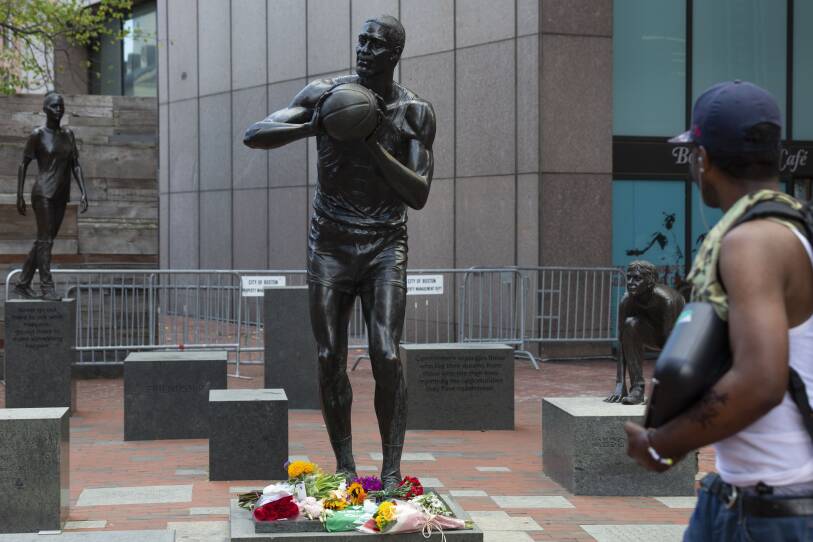The statue honoring Celtics legend Bill Russell has become a sacred space in the days since the player-coach died Sunday. Fans have been dropping by City Hall plaza to leave flowers at its sneaker-clad feet, honoring his work on and off the court.
The statue shows Russell in his No. 6 Celtics about to make a chest pass, the basketball pressed between his palms. Around him are 11 granite plinths, one for each championship he won with the Celtics, inscribed with quotes like “There is no such thing as other people’s children. They are the next generation of Americans.” Climbing the plinths are two children, a boy and a girl, representing Russell’s mentorship of youth.
One of the people who came to pay tribute was Roxbury resident Gregory Baker, who said he admired Russell’s civil rights advocacy. Russell was part of Martin Luther King Jr.’s march on Washington in 1963, and often spoke of the racism he and other Black players faced in Boston.
“I applaud him for everything he did back then,” Baker said, standing by the statue on City Hall Plaza. “He was there with Dr. King, Ali, Jim Brown and everybody else. With Kareem Abdul-Jabbar, when he was Lew Alcindor. They stood up for what they thought was right.”
The statue was not something that Bill Russell initially wanted, said Ann Hirsch, the public artist who designed it in collaboration with Pressley Associates Landscape Architects. He wasn't one for the spotlight and only agreed to it on the condition that the project generated a grant program to go towards mentorship initiatives for children.
“He was a little bit reluctant about having a sculpture of himself put on City Hall Plaza,” Hirsch said. “It wasn't something that he was very interested in seeing, and that was consistent with the man that he was.”
Russell agreed to the project so long as it promoted and raised money for mentorship programs. So Hirsch went to Seattle to have lunch with Russell and his daughter, attorney Karen Russell. She ended up speaking with him for nine hours.

“It was moving and it was powerful,” Hirsch said. “The conversation became about basketball, and it became about how basketball is a doorway into so many other ideas that Mr. Russell was really committed to, and especially mentorship.”
Russell spoke about his experiences playing basketball in high school, and the hard work he put in to become an elite athlete. He talked about losing his mother at the age of 12 and about his civil rights work and mentorship.
“We had a commitment to honor not just Bill Russell the athlete, not just Bill Russell the player-coach, but also Bill Russell the national mentorship leader and the human rights and civil rights activist,” Hirsch said. “The sculpture speaks to all of those different dimensions to who Bill Russell was.”
The placement of the sculpture, near the center of political power at City Hall and not far from the Boston Massacre site, is also intentional. Russell spoke about racism in Boston often, both through his own experiences and through issues like segregation in schools.
“Choosing City Hall Plaza as the place to install this sculpture, it speaks to the fact that he isn't just an athlete. He was so many other things,” Hirsch said. “This site is very important. It has a lot of history when it comes to the racist history of Boston, but also just the revolutionary history. All of those things were in the back of our minds when we were thinking about the site.”
The way Russell is posed, his hands holding a basketball and about to launch a chest pass, represents his teamwork, Hirsch said.
“Showing him as a team player by having him throw a chest pass to another team member, it speaks to his supporting other people beyond the court,” Hirsch said.
This story has been updated to reflect that Hirsch collaborated with Pressley Associates Landscape Architects on the statue project.








